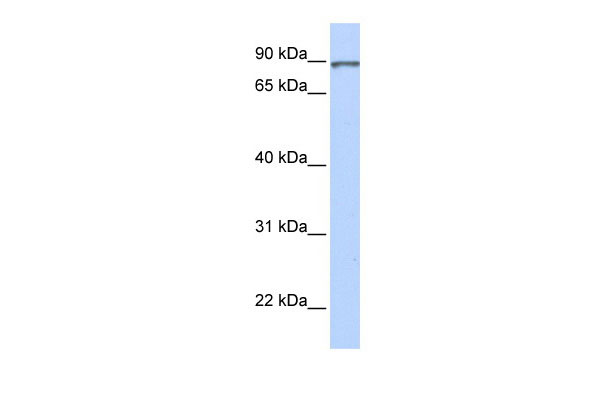L3MBTL antibody - N-terminal region
Rabbit Polyclonal Antibody
- 产品详情
- 实验流程
Application
| WB |
|---|---|
| Primary Accession | Q9Y468 |
| Other Accession | NM_015478, NP_056293 |
| Reactivity | Human, Dog |
| Predicted | Human |
| Host | Rabbit |
| Clonality | Polyclonal |
| Calculated MW | 92297 Da |
| Gene ID | 26013 |
|---|---|
| Alias Symbol | DKFZp586P1522, FLJ41181, H-L(3)MBT, KIAA0681, L3MBTL1, dJ138B7.3, L3MBTL |
| Other Names | Lethal(3)malignant brain tumor-like protein 1, H-l(3)mbt, H-l(3)mbt protein, L(3)mbt-like, L(3)mbt protein homolog, L3MBTL1, L3MBTL1, KIAA0681, L3MBT, L3MBTL |
| Format | Liquid. Purified antibody supplied in 1x PBS buffer with 0.09% (w/v) sodium azide and 2% sucrose. |
| Reconstitution & Storage | Add 50 ul of distilled water. Final anti-L3MBTL antibody concentration is 1 mg/ml in PBS buffer with 2% sucrose. For longer periods of storage, store at 20°C. Avoid repeat freeze-thaw cycles. |
| Precautions | L3MBTL antibody - N-terminal region is for research use only and not for use in diagnostic or therapeutic procedures. |
| Name | L3MBTL1 |
|---|---|
| Synonyms | KIAA0681, L3MBT, L3MBTL |
| Function | Polycomb group (PcG) protein that specifically recognizes and binds mono- and dimethyllysine residues on target proteins, thereby acting as a 'reader' of a network of post-translational modifications. PcG proteins maintain the transcriptionally repressive state of genes: acts as a chromatin compaction factor by recognizing and binding mono- and dimethylated histone H1b/H1-4 at 'Lys-26' (H1bK26me1 and H1bK26me2) and histone H4 at 'Lys-20' (H4K20me1 and H4K20me2), leading to condense chromatin and repress transcription. Recognizes and binds p53/TP53 monomethylated at 'Lys-382', leading to repress p53/TP53- target genes. Also recognizes and binds RB1/RB monomethylated at 'Lys- 860'. Participates in the ETV6-mediated repression. Probably plays a role in cell proliferation. Overexpression induces multinucleated cells, suggesting that it is required to accomplish normal mitosis. |
| Cellular Location | Nucleus. Note=Excluded from the nucleolus. Does not colocalize with the PcG protein BMI1, suggesting that these two proteins do not belong to the same complex |
| Tissue Location | Widely expressed. Expression is reduced in colorectal cancer cell line SW480 and promyelocytic leukemia cell line HL-60. |
Research Areas
For Research Use Only. Not For Use In Diagnostic Procedures.
Application Protocols
Provided below are standard protocols that you may find useful for product applications.
REFERENCES
Min,J., (2007) Nat. Struct. Mol. Biol. 14 (12), 1229-1230 Reconstitution and Storage:For short term use, store at 2-8C up to 1 week. For long term storage, store at -20C in small aliquots to prevent freeze-thaw cycles.
终于等到您。ABCEPTA(百远生物)抗体产品。
点击下方“我要评价 ”按钮提交您的反馈信息,您的反馈和评价是我们最宝贵的财富之一,
我们将在1-3个工作日内处理您的反馈信息。
如有疑问,联系:0512-88856768 tech-china@abcepta.com.























 癌症的基本特征包括细胞增殖、血管生成、迁移、凋亡逃避机制和细胞永生等。找到癌症发生过程中这些通路的关键标记物和对应的抗体用于检测至关重要。
癌症的基本特征包括细胞增殖、血管生成、迁移、凋亡逃避机制和细胞永生等。找到癌症发生过程中这些通路的关键标记物和对应的抗体用于检测至关重要。 为您推荐一个泛素化位点预测神器——泛素化分析工具,可以为您的蛋白的泛素化位点作出预测和评分。
为您推荐一个泛素化位点预测神器——泛素化分析工具,可以为您的蛋白的泛素化位点作出预测和评分。 细胞自噬受体图形绘图工具为你的蛋白的细胞受体结合位点作出预测和评分,识别结合到自噬通路中的蛋白是非常重要的,便于让我们理解自噬在正常生理、病理过程中的作用,如发育、细胞分化、神经退化性疾病、压力条件下、感染和癌症。
细胞自噬受体图形绘图工具为你的蛋白的细胞受体结合位点作出预测和评分,识别结合到自噬通路中的蛋白是非常重要的,便于让我们理解自噬在正常生理、病理过程中的作用,如发育、细胞分化、神经退化性疾病、压力条件下、感染和癌症。






